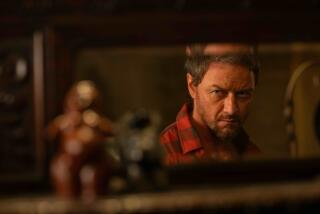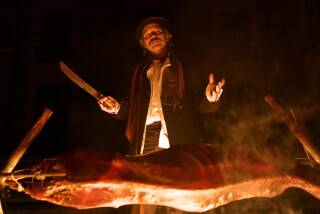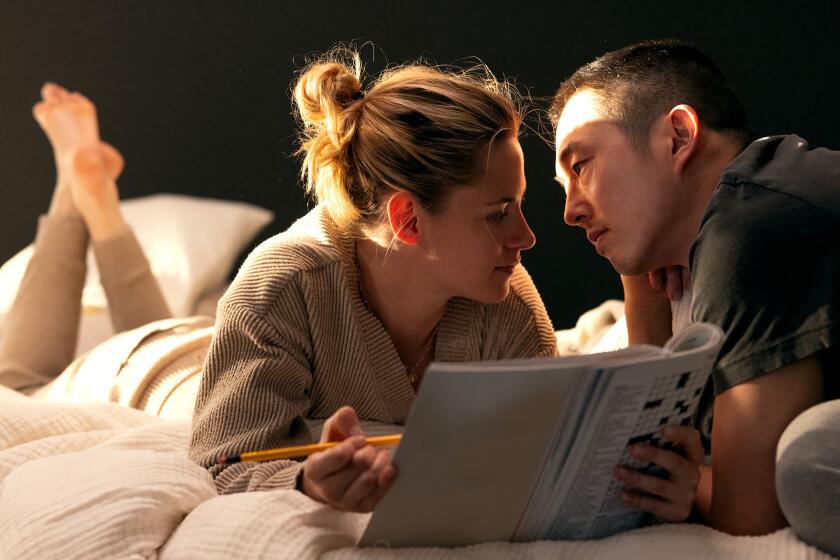Review: A mature love story, ‘Hope’ conveys respect for relationships and illness
- Share via
The Times is committed to reviewing theatrical film releases during the COVID-19 pandemic. Because moviegoing carries risks during this time, we remind readers to follow health and safety guidelines as outlined by the Centers for Disease Control and Prevention and local health officials.
The great love stories, the ones that care about more than surface tingles, are invariably illness stories too, steeped as they are in the turbulent details of symptoms, ache, confusion, diagnosis, treatment and cure (forever-after health not always being the case if tissues are needed). Which may be why the movie romances that introduce physiological ailment can too often feel conveniently engineered, a shortcut to suffering: the second-act cough that’s both hacking and hackneyed.
But Norwegian filmmaker Maria Sødahl, with her remarkable feature “Hope” — about a terminal diagnosis’ effect on a well ensconced but estranged couple — has found something miraculous and moving: an adult love story born of mortality, built from the remnants of a connection long thought lost, navigated in tandem with sickness. And because of that emotional intelligence, it’s fluidly both specific and universal.
We meet middle-aged choreographer Anja (Andrea Bræin Hovig) in the wings of a theater, proudly if sadly looking on at the finale of a dance she’s created. She’s been out of the country for work, tending to an artistic career long stalled by motherhood, and upon her return finds a Christmas-prepping household in merry disarray. Her much older partner, Tomas (Stellan Skarsgård), a theater producer, has chosen his own work rather than watching their three biological children, instead leaving his trio of older kids from an early marriage, visiting for the holidays, to be babysitters.
It wasn’t what they agreed, Anja tells him, but what else is new about their increasingly separate lives? What’s more pressing in her mind are the headaches that won’t go away. When an immediate MRI shows brain metastases from a prior bout with lung cancer, and doctors inform her that time is short, the way ahead becomes urgently clear to Anja: She and Tomas must become a team again, a united parenting front of caring and strength, if their blended clan — from grade school age to adult — is going to find the resolve to endure the inevitable.
But in the hurly-burly of a yuletide season suddenly turned into a tense mix of hard news, reflection, hospital appointments, mood-altering medication and now even more meaningful Christmas rituals with family and friends, Anja and Tomas encounter an unexpected side effect to their mission of mutual reliance: They learn to see each other again and to truly love each other and learn who the other person really is. That they’re on a terrible clock gives this blossoming a strangely compelling, no-nonsense urgency, with room even for grace notes and humor.
Surely one of the harder stories for any movie to pull off is the rekindling of something we never witnessed in the first place. But from the very start, with Hovig’s and Skarsgård’s early sketching of a bond tenuous but still integral, the seeds are in place for the startling, edgy and messily beautiful re-sowing of intimacy that follows. Not only do their bodies tell that story, especially in a poignantly acted bed scene, but as they ping between doctors and loved ones, their words and expressions leave nothing behind — anger, tenderness, compassion, fear — as they learn to treasure a connection that keeps them going.
In suggesting a complicated history through which something new can be cherished, Hovig and Skarsgård are giving a concise master class here in love’s maturity, one nurtured beautifully by Sødahl’s unobtrusive yet attentive camerawork and real-life pacing of scenes.
“Hope” isn’t about getting you to cry, even as some of its characters occasionally do, but rather giving you an invigorating, even uplifting sense of what hearts can do under duress; nothing is forcibly tragic here, just experienced fully and openly.
It’s why a movie about terminal cancer — a diagnosis Sødahl herself received 11 years ago — can be called “Hope.” Not because she survived, but because she knew what a movie about her experience had to be, about the hope not just to live through something, or die with something, but to get perspective on it all with the time left. It’s also why I can’t get over, especially from a movie made before the pandemic, how beautifully wise and respectful of love and illness her final shot is — an image of being and seeing I wish for everyone when it matters most.
'Hope'
In Norwegian with English subtitles
Not rated
Running time: 2 hours, 5 minutes
Playing: Starts April 16, Laemmle Monica Film Center, Santa Monica; Laemmle Town Center 5, Encino; Laemmle Playhouse 7, Pasadena; and Laemmle Virtual Cinema
More to Read
Only good movies
Get the Indie Focus newsletter, Mark Olsen's weekly guide to the world of cinema.
You may occasionally receive promotional content from the Los Angeles Times.










